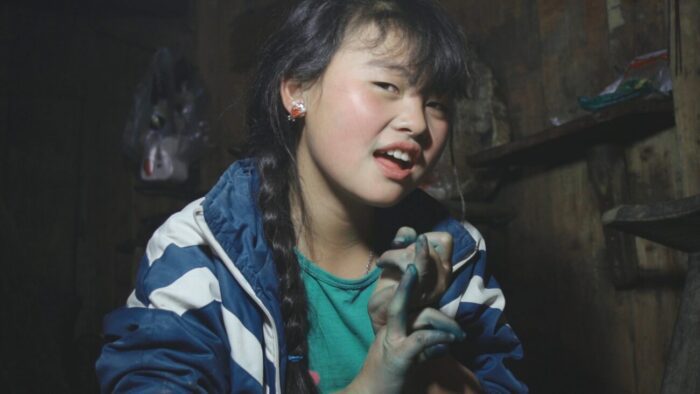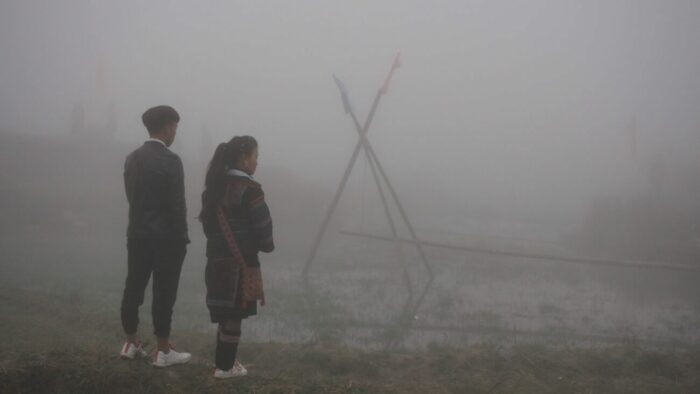Di—the 12-year-old girl at the center of Hà Lệ Diễm’s extraordinary documentary Children of the Mist—is in many ways a normal adolescent girl. Her village life rotates between chores and school, with her free time largely preoccupied by girl talk with her friends and what seem like innocuous flirtations with local boys. But in the misty Vietnamese mountain village where Di and her family live, a long-honored tradition—one they call “bride kidnapping” and that means exactly what it says—poses both an opportunity and a threat for a girl too young to find her future sealed.
Hà Lệ Diễm spent three years with Di and her family, a commitment that allowed her to develop a mutual trust with her subjects. Those include Di, a charming schoolgirl with a high-pitched giggle that sometimes masks her more scholarly ambitions. She’s the first generation of her family with access to formal education. At school she learns of the opportunities afforded women in the world beyond her village. At home she learns the ways of her family’s traditions: her parents squabble (sometimes riotously), drink (sometimes copiously), and work (seemingly endlessly).

At age 12, Di is just beginning to think seriously about her future and what she might want from it, but her notions are inchoate. She might want a career, maybe lots of money, boyfriends at her feet, but any interactions she has with boys are limited to social-media flirtations—the presence of smartphones is no less ubiquitous in the hills of North Vietnam than anywhere else in the world. Di has hopes for the future, but a future beyond her family farm seems far, far away.
For the first half of Children of the Mist, Diễm charts Di and her family’s life with a quiet, calm, innocuous approach. She records her subjects speaking to each other, rarely to the camera, and the family goes about their chores without much apparent attention to the fact a documentary is being made of them. Di’s mother accuses the father of drunkenness (clearly correctly); he retaliates with accusations of infidelity. They seem almost unaware of the camera’s presence, and Diễm continues charting their daily chores and occasional celebrations.
In this way Children of the Mist registers at first as an almost purely observational documentary in the mold of the Maysles brothers or Frederick Wiseman. The mist that rolls up and along the hillsides of the family village in Tonkin charts the slow ebb and flow of time passing with each day’s chores. Only occasionally will any of the characters seem to recognize the camera or its operator, and as a result it feels like we viewers are simply immersed in the family’s work and the region’s culture. At the same time, it’s clear that Diễm has worked hard to earn Di and her family’s trust.
Subtly, slowly, a theme develops through the film’s careful editing: the coming of the Lunar New Year and with it, an occasion for the tradition of “bride kidnapping” that remains an accepted practice among the indigenous Hmong community. Di’s unseen older sister was one “kidnapped bride” at age 14 and is now pregnant for the second time at 17. Di’s mother was one, too. Vietnamese law sets the minimum age at 18 for women and 20 for men, but it’s clear the customs of the Hmong outweigh the letter of the law.
Time is passing, and has passed: Di is transitioning from prepubescence to adolescence, becoming in the process a bit more bold in her interactions with boys. She and her friends’ girl chat has become a bit more salacious and her demeanor a bit more flirtatious. And at a celebration of the Lunar New Year, one boy in particular, a smoothie with a haircut and a selfie stick from a neighboring village, starts courting Di. As the two leave the festival together, he turns to the camera and politely tells it not to follow them any further. Diễm’s camera stops and records the two disappearing together down the dirt road away from her village.

The scene feels like an ending but is in reality the beginning of a new and even more challenging chapter in Di’s life. When she doesn’t return home, her parents recognize she’s been “kidnapped” and start deliberating: Is Di (now 13) old enough to marry? Is the boy an appropriate match? If so, what should they ask for the dowry?
Diễm follows multiple threads here—the parent’s worries, their negotiations with the prospective husband’s family, and Di’s own increasing doubts—adroitly, cross-cutting between significant and charged moments of dialogue addressing each. Even Di’s schoolteachers are concerned enough to attempt an intervention of sorts. I can’t say enough about how masterfully the film is shot and edited. even while the principals are always front and center, Diễm’s camera manages always also to capture the significance of other subjects, objects, settings, and their relations to each other, the whole of the mise-en-scène communicating far more than the simple transcription of spoken words.
As the tensions between an increasingly regretful child bride, her addled parents, the prospective groom and his pushy parents, and the community escalate, Di’s situation becomes precarious, even harrowing. It’s hard not to wonder if the filmmaker herself might have intervened more directly, or what might have become of the subject had Diễm and her camera not been present (Di’s alternative might have been far worse than what is depicted). To what extent a documentary subject’s behavior might be altered by the presence of the camera has been a conundrum of the medium going back to Flaherty’s Nanook; in Children of the Mist, the subjects may seem largely unaffected by its presence, but their actions may well have been tempered.

Regardless, Children of the Mist is an astounding documentary, presenting us with a compelling, likable protagonist in a difficult situation, one at the exact intersection of tradition and modernity. While Hà Lệ Diễm’s camera focuses explicitly on one young Hmong girl dreaming of a life her family has never known, one suspects a similar story unfolding every day in her small village and others like it. Beautifully shot, expertly edited, and brilliantly conceived, Children of the Mist is a stunning study of girlhood.
Winner of Best International Film at DocAviv and Best Directing at IDFA, Children of the Mist premieres at New York’s Firehouse Cinema December 16, 2022.



